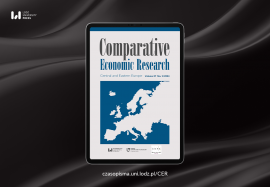Comparative Economic Research. Central and Eastern Europe | Vol. 27 No. 1
Opublikowano: 10 maja 2024

Comparative Economic Research. Central & Eastern Europe has been published since 1998 by the Institute of Economics at the Faculty of Economics and Sociology of the University of Lodz, one of the leading universities in Poland.
The aim of the periodical is to publish the original results of empirical comparative research in the field of economic and social sciences, mainly concerning the countries of the European Union and countries from Central and Eastern Europe.
As part of economic and social research, the following is particularly important:
- Macroeconomic issues, with particular emphasis on:
- economic growth and sustainable development,
- globalization of the economy,
- labor market,
- financial market,
- technology transfer,
- development economics,
- issues of European economic integration, with particular emphasis on the functioning of the European Single Market and the transformation of both economic and social policies into the following directions of:
- counteracting the negative effects of climate change,
- circular and digital economy,
- in-depth analyzes of the consequences of the COVID-19 pandemic for EU Member States in the context of new challenges related to the achievement of the UN
- Sustainable Development Goals by 2030,
- strengthening the competitiveness of the European economy,
- comparative analyses of the position of the main “players” (including BRICs) in the global trade, services, capital and labor markets.
- Microeconomic issues related to the role of small and medium-sized enterprises in the context of their internationalization and the ability to create innovation.
Inside Vol. 27 No. 1:
Małgorzata Jabłońska
The paper analyzes the relationship between innovation dimensions, according to the European Innovation Scoreboard, and the entrepreneurship rate in a group of moderate innovator countries. Using the Pearson linear correlation, the author conducted a data analysis based on an empirical study using open data from the Summary Innovation Index – European Innovation Scoreboard (SII‑EIS) and Eurostat for 2013–2019. This period covers the moment when all the countries of the Visegrad Group (i.e., the Czech Republic, Hungary, Poland, and Slovakia – the V4) were classified into the same innovation group according to EIS. However, due to the volume limitations of the article, it was decided that Moderate Innovators from 2019 would be included in the comparative analysis, i.e., when the V4 were last collectively classified as Moderate Innovators. The results of the research positively verify the initial research hypothesis that the EIS indicators show a different strength of relationships with the entrepreneurship rate in the V4 and among other economies classified as Moderate Innovators (according to SII–2020).
The variables that describe the quantity and quality of entrepreneurs’ innovations strongly and positively impact the V4 countries’ entrepreneurship rate. In other countries, the variables derived from the investment attractiveness of economies show a significant and positive correlation with the entrepreneurship rate. Based on the analysis of the results, it can be concluded that there is a strong positive correlation between the entrepreneurship rate and the total innovation index, which is compiled each year based on a set of variables for the European Union countries. The study showed that the entrepreneurship rate in these countries is strongly impacted by indicators representing the following groups: Innovators (small and medium‑sized enterprises (SMEs) with product or process innovations; SMEs with marketing or organizational innovations and SMEs innovating in‑house), Attractive research systems (international scientific co‑publications), Finance and support (Venture capital expenditures), Firm investments (Enterprises that provide training to develop or upgrade their personnel’s ICT skills), and Linkages (Innovative SMEs that collaborate with others). The impact of these factors on the development of entrepreneurship in the V4 means that pro‑innovative activities undertaken in operating enterprises strongly correlate with deciding to start one’s own business. Therefore, it can be concluded that entrepreneurship in these countries has an entirely different development basis than in other countries that are Moderate Innovators, where the factors mentioned above were irrelevant.
A Comparative Analysis of Key Integration Blocks
Leszek Jerzy Jasiński
Why is integration progressing successfully in some parts of the world but not in others? Why are only some integration blocks hugely important for member countries? And why this is not the case globally? This article provides a comparative analysis of international economic structures, aiming to identify the factors that contribute to the validity and effectiveness of integration.
The article examines eight economic blocks: the European Union, the Agreement between the United States of America, the United Mexican States and Canada, the Southern Common Market, the Association of Southeast Asian Nations, the Euroasian Economic Union, the South Asian Association for Regional Cooperation, the African Union, and the Regional Comprehensive Economic Partnership. We take into account five stages of integration: free trade area, customs union, single market, economic union, and monetary union. To understand the progress of integration, one must consider a number of developments and indicators. The coefficient of economic gravity, which we describe in this paper, is a convenient method to find out how important integration structures are for contracting states.
Tomasz Grzegorz Florczak, Iwona Dorota Czechowska, Adam Kucharski, Joanna Stawska, Sophia Lobozynska
Research background: The importance of the financial sector for the real economy has increased as there has been a transition from industrial capitalism to financial capitalism in recent years. The increasing importance of the financial sector is referred to as financialisation, and it is undoubtedly associated with finance, financial operations, or an increase in the importance of profits generated by financial activities. Financialisation is a long‑term process characterised by the growth of the banking sector. Purpose of the article: This article compares the effectiveness of banking sectors in the European Union (EU) countries from the financialisation perspective.
Methods: The study determined the efficiency of the banking sectors for the 28 EU countries using an input‑oriented, non‑radial BCC model in 2017 and assessed changes in the efficiency of the entities studied using the Malmquist index between 2008 and 2017.
Findings & value added: With certain outlays and effects, the banking sectors of seven countries were effective in 2017 from the financialisation perspective: Cyprus, Denmark, France, Luxembourg, Malta, Sweden, and the United Kingdom. The effectiveness of individual inputs for the banking sectors from each country was then determined, and benchmark leaders were identified. The analysis of the dynamics of changes in the efficiency of the banking sectors showed that Sweden had the highest values of the Malmquist index between 2008 and 2017 (where efficiency increased by 37.7%).
Magdalena Kowalska, Anna Misztal, Rafał Matera
The article’s main aim is to assess the impact of economic security on sustainable entrepreneurship in Central and Eastern European Countries (CEECs), including Bulgaria, Croatia, Czechia, Estonia, Hungary, Lithuania, Latvia, Poland, Romania, Slovakia and Slovenia from 2008 to 2020. The paper’s novelty is the development of indicators of sustainable entrepreneurship and its three pillars: economic, social and environmental. Moreover, we assessed the impact of economic security on sustainable entrepreneurship and conducted a comparative analysis of its consequences on the economic, social and environmental components of entrepreneurship. We use the Pearson correlation coefficient, the Ordinary Least Square Method, and the SUR estimations for structural equations. The results of the analysis indicate that sustainable entrepreneurship and economic security in the analysed countries are growing. However, their dynamics are varied, and what is more, economic security has a statistically significant impact on sustainable entrepreneurship. The impact of economic security on sustainable entrepreneurship from 2008 to 2020 is highest in Slovakia, Bulgaria and Poland. The lowest is in Latvia, Romania and Czechia. We notice that pursuing a stable and responsible macroeconomic policy affects the implementation of sustainable development goals. It is important to create the best conditions for growth in the long term, which is a challenge because of the problem of finding optimal relationships between factors that determine economic security.
Financial Constraints on Firm Growth: The Role of Firm Age in the ASEAN–6
Yee Ling Ng, Wei Theng Lau, Wei Ni Soh, Nazrul Hisyam Ab Razak
The paper assesses the moderating role of firm age in the relationship between financial constraints, as measured by the KZ index, and the WW index on three alternative measures of firm growth (Asset growth, ROA, and ROE) in the ASEAN–6 region. This study employs a sample of ASEAN–6 listed firms over the period 2009–2019 using Fixed Effects and the System GMM model. Firm age is found to interact positively with financial constraints in their effects on firm growth. The negative impact of financial constraints on firm growth is less severe with older age firms.
The Role of Digital Services Trade Restrictiveness in Exports: Before and During COVID–19
Sri Indah Nikensari, Shanty Oktavilla, Navik Istikomah, Nindya Farah Dwi Puspitasari
Digital technology has penetrated various fields, including international trade. This study aims to analyze how barriers/openness to trade in digital services affected exports before the COVID–19 pandemic (2015–2016) and during the pandemic (2019–2020). Based on the Gravity model, exports seem to be influenced by digital services trade restrictiveness, including infrastructure and connectivity restrictions (X1), electronic transaction restrictions (X2), and other restrictions (X3). The panel data regression equation was used to analyze data from various countries (European 17 countries, Asian 8 countries, and Latin American 3 countries) sourced from OECD Statistical Data. The selection of sample countries was based on data availability and homogeneity. The results showed that the effect of digital services trade restrictiveness on exports was low before the pandemic and increased during the pandemic era. Prior to the pandemic, restrictions on electronic transactions had a weak and negative impact on exports; meanwhile, during the pandemic, all restrictions impacted exports, except for other restrictions. In the pandemic era, restrictions on infrastructure & connectivity had a negative impact, but restrictions on electronic transactions had a positive impact on exports due to a decline in global exports and several countries reducing restrictions on electronic transactions.
Igor Kravchuk
The purpose of the article is to identify key banking activity models in Ukraine and show how they changed under the influence of the Revolution of Dignity, the COVID–19 pandemic, and the imposition of martial law. The proposed method uses cluster analysis of the main indicators for banking activity (concerning assets, liabilities and income) based on Ward’s agglomerative hierarchical clustering algorithm and the Tau index in the NbClust package as the criterion for evaluating the optimal number of clusters. The research covers all Ukrainian banks, spanning the period 2013–2022.
In 2014 (after the Revolution of Dignity), the actions of the National Bank of Ukraine (NBU) had a positive impact on the models of Ukrainian banks: there was no opaque model of banks and banking models became more transparent and more resilient to financial shocks. Between 2021 and 2022, five banking models were identified: universal banks, wholesale funding banks, corporate‑investment banks, retail banks, and commission banks. The negative impact of COVID–19 on the Ukrainian economy was reflected in all banking models by the following: (1) a significant increase in the role of securities in assets, which was caused by a decrease in lending due to an increase in their riskiness; (2) the use of central bank funds to liabilities management, which was evidence of a deterioration in financing conditions in the deposit market.
The following main changes in Ukraine’s banking system at the end of 2022 (during the war) were identified: (1) a decrease in the number of banks that mainly use funds from the NBU to support their activities; (2) the closure of only four banks by the NBU (including two with majority shareholders from Russia) during the year; (3) an increase in the share of the non‑government debt securities portfolio in banks’ assets; (4) declines in ROE and ROA for all banking models during the war, and three banking models became unprofitable; (5) the significantly higher share of non‑performing loans in the credit portfolio for all banking models, especially for the retail banking model.
The value‑added of this research is the analysis of how banking models in Ukraine have changed at the micro level (reflected in the financial statements) inter alia in wartime.
The Development of the Cooperative Banking Sector in Selected Central and Eastern European Countries
Anna Nowacka
The study assesses the development of the cooperative banking sector in selected Central and Eastern European (CEE) countries against the average statistics of the segment in those countries. It also compares it to the largest European cooperative banking group in Germany. The article presents the results of an analysis of the cooperative banking sectors between 2016 and 2021 in Poland, Bulgaria, Romania, Hungary and Germany, all of which are members of the European Association of Cooperative Banks (EACB). The selection criterion was based on the availability of detailed data on cooperative banks published by the EACB on a temporal and spatial basis.
The empirical basis for the issues addressed in the article is a review of the reference literature and the comparative analysis of the development of the cooperative banking sector using a synthetic development indicator for the period 2016–2021. According to the theoretical and empirical analysis, Romania demonstrates the lowest level of development of the cooperative banking segment. In turn, the Polish and Bulgarian cooperative banking sectors represents a higher level of development than the Romanian one. Hungary has reached the highest level of development in the group of Central and Eastern European countries. While comparing the CEE countries to the German cooperative banking sector, their development was almost one and a half times lower and, in the case of Romania, three times lower.
Agnieszka Szulc‑Obłoza, Małgorzata Szczepaniak
Social cohesion and a sustainable labour market remain the aims of sustainable development policy. However, income inequalities and labour market policies are more often separately analysed. To fill the identified research gap, our article presents the results of an analysis of interactions between active and passive labour market policies and income inequalities in the European Union. The 27 countries were divided into two clusters based on their active and passive labour market policy (LMP) expenditures in 2019. These clusters sustain the basis for analysing the interactions between LMP and income inequalities in its different measures. The results reveal that labour market interventions interact with income inequalities, decreasing disposable income inequalities (equalising the disposable income after transfers and taxes) and therefore contributing to social cohesion. This paper concerns social cohesion as the manifestation of intragenerational justice.
Komentarze
Ten post dostępny jest także w języku: angielski





